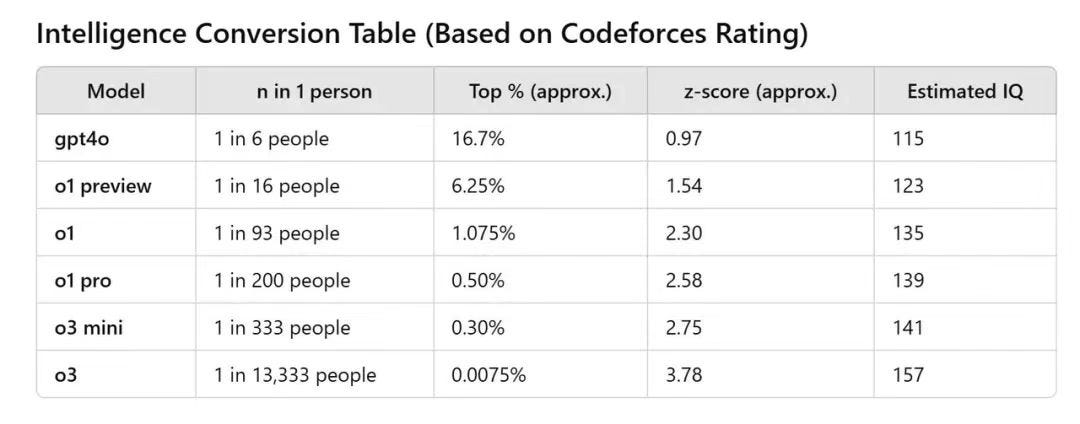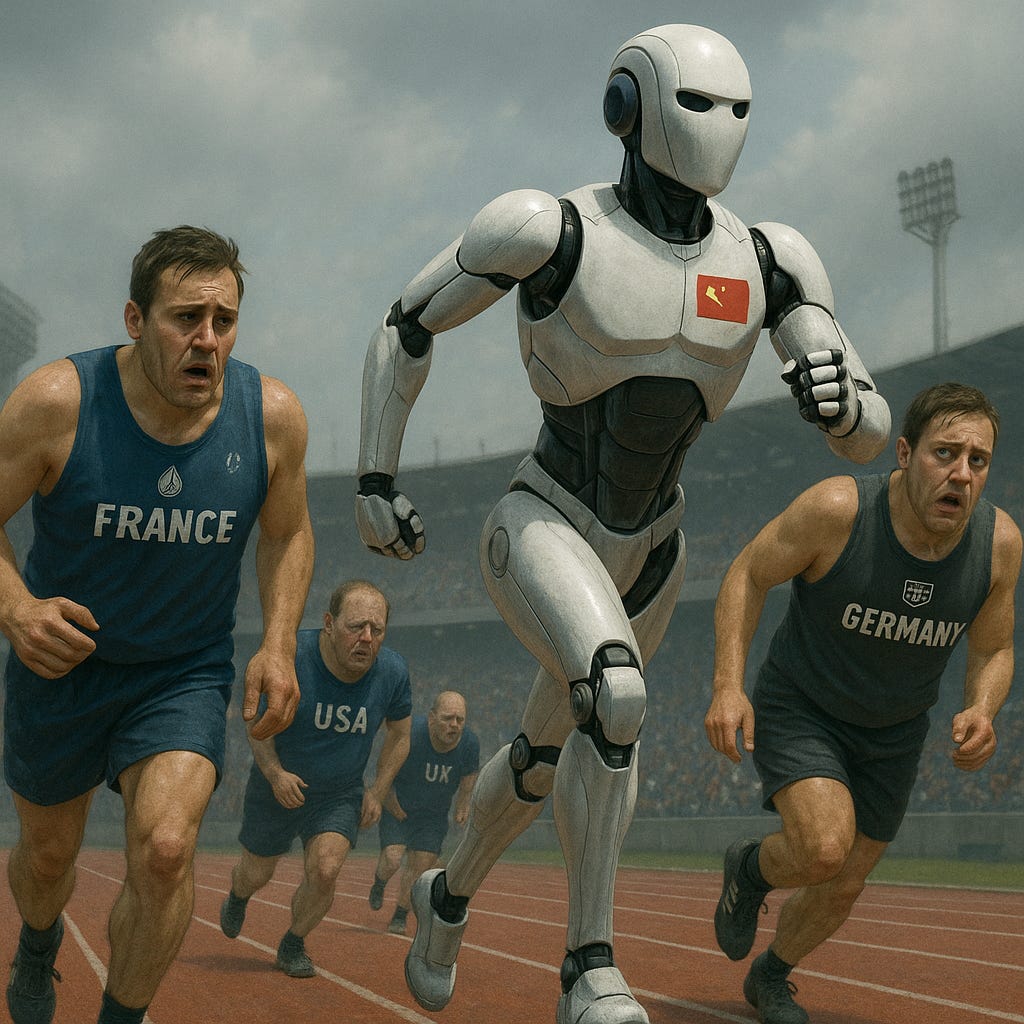Robots Will Take Your Job in 10 Years.
And its looking like they'll be Chinese, not American
Before 2020, AI was really really good at one thing: chess. It could outplay the best grandmasters. But it couldn’t tell a dog from a cat. It couldn’t create a piece of art, a poem, or remember what you said a few minutes ago. If you didn’t ask a question in a hyper-specific way, it crumbled.
Fast forward to today. Leading AI models are likely to get kicked off the top faster than Kings in Westeros. While OpenAI’s staff popped champagne for GPT-4o’s release, DeepSeek released DeepSeekR1 at a fraction of the training cost. A month later, Google released Gemini 2.5, upending the AI landscape for the 1st 2nd 14th time. You could now upload 1 million tokens into Gemini 2.5 (128K–400K for rivals). And it’s free! And then Anthropic, seeming to fall behind, released Claude 4 Opus just last week, putting it squarely in competition again with OpenAI and Google.
And GPT-5 is waiting in the wings for a July release date, of course...
What does all this mean, really?
Well, ChatGPT is in the 90th percentile for the bar exam, Google scored 85 percent on the U.S. medical licensing exam. Gemini 2.5 Pro solves 86.7% of AIME problems. (The AIME is the second of two tests used to determine qualification for the U.S. Mathematical Olympiad) Some estimates have OpenAI’s o3 testing at a 157 IQ. It increased 42 points in just 7 months!
I believe that the power of AI to change the world is properly rated at this point. There are all the suburban dads and moms who don’t know anything about how revolutionary the technology is and will soon be, but on the other hand, there are all the tech bros hyping it up to infinity and beyond. So on net, I think AI is appropriately rated, perhaps a bit underrated publicly and a bit overrated on the internet.
But it seems like nobody is talking about the other revolution going on right now.
Yes, that Unitree robot, which can also do a side-flip (how many Americans can do a side flip, 10%? 5%? 1%?) and Kung Fu, is only 16,000 dollars. You can buy it today. So no, this blog post isn’t “aren’t these robots startlingly dexterous! And these projections say they’ll be commercially viable in less than 5 years! Imagine how good they’ll be in 15!” No, they are startlingly dexterous and commercially viable right now, which means a disruption of the economy’s demographic makeup is not beyond the horizon, it’s already begun.
And always remind yourself, this is the worst they will ever be.
Not only are they being sold to people like us, but also to manufacturers. As of last year, Mercedes has begun using humanoids in its assembly lines.
Audi and BMW have also begun preliminary testing.
And this is just Europe. As you know, Europe usually watches from the corner while either the U.S., China, or both leapfrog them technologically. This industry is no exception.

This is the problem. I expect Europe to be a benchwarmer for Western civilization anyway.
But I’m unpleasantly surprised by the U.S.’s mediocrity in the robotics industry.
China has been living in a different world for years. Strategic government investment and cultural excitement around robots have produced factories that can make a smartphone a second, for 24 hours a day, with zero humans. They call them “lights out” factories. And there are more, see here and here. The U.S. doesn’t have anything like that, not even close.
Just look at this graph again.
China’s yearly installations dwarf those of the four western powers combined. Just 10 years ago, China was on par with the others. Now it lives on a different planet. Just a couple weeks ago, they held a robot marathon in Beijing. The people are excited about the technology, the government has all its chips in on it, and they’re making tremendous progress on making the 1960s science fiction novels a reality! What do you call this except a robotics revolution?
And yet, it is getting completely ignored by the West.
Industrial robots, cobots, (collaborative robots) and humanoids are all collections of software and hardware. This Unitree humanoid has 94 sensors on its hand. This hardware is important, but so is the software that can sequence the right actions, and make adjustments based on environmental feedback.
Sadly, the man who was known for beautifully and innovatively marrying hardware and software has long passed. With our modern Henry Ford dead on the eve of Chinese technological dominance, now more than ever do we need someone to fill his shoes. (On second thought, he wore shoes rarely) The Bill Gates philosophy of software dominance seems to reign supreme in Silicon Valley again, with almost all of its innovation concentrated in AI, and not robotics. So we need a new Randian hero to carry Jobs’ integrationist approach into the mid-21st century.
Thankfully, innovative companies like Tesla and Amazon are at least trying to keep the U.S. competitive. Amazon has been using cobots such as autonomous warehouse movers for some time now. Recently, it has begun testing humanoids to actually deliver packages and place objects in higher spaces around warehouses. Tesla is of course innovating on humanoids with its Tesla Optimus, but it is falling behind its Chinese rivals.
For example, at the 2024 World Robot Conference held in Beijing, (where else would it be held?) over 27 different humanoids were shown off to the dazzled eyes of Chinese consumers. The Unitree H1, China’s best humanoid, was up and about, and even performed synchronized choreography with both H1’s and humans nearby in Feb 2025. Meanwhile, America’s shining star, the Tesla Optimus, sat motionless in a glass box.
If China were democratic, I wouldn’t care. I would be happy that they are innovating, overjoyed actually. Matter of fact I’d move over there and never eat a burger again.
But I don’t feel that way. To borrow from Tolkien, I feel like Treebeard or Théoden. Isengard has invented new Orcs and black powder technology, and industrialized beyond our realm’s capability.
All the while we and our allies sit on our hands while peace exists temporarily, and the prospect of at least power parity or, most importantly, a free and liberal future, seems to stretch further and further away from our imagination.
I admire Chinese civilization. China’s explosion of economic growth has been one of the single best events in human history. I’m happy Chinese people aren’t starving and impoverished, and have high-speed rail and robot conventions and a great scientific establishment and so forth. We have much to learn from China.
But they are much too Orwellian. Xi uses the judiciary as a knife handle for the CCP. People speak in hushed tones, even at the dinner table, for fear their phones are listening. The government routinely lies about almost everything, even incredibly basic and important things like gross domestic product.
Europe and the U.S. need to catch up on robotics. Manufacturing and distribution industries have already begun to embrace them. Soon will come construction, agriculture, and even service industries like healthcare and caregiving. Aurora Innovation has launched a commercial driverless trucking service in Texas, making deliveries between Dallas and Houston.
Brian Potter is skeptical of a robot revolution. He doesn’t think they’re dexterous enough. Yes, they can flip and kick and run. But they can only do rudimentary tasks with their hands, like folding or picking up a plate.
But there are optimists too. Goldman Sachs Research revised its global humanoid market outlook by 6x(!) in 2024, forecasting the market to reach $38 billion by 2035. This is a sixfold increase from their prior estimate of ~$6 billion reflects how rapidly expectations have grown as technological hurdles fall.
Morgan Stanley is even more optimistic. Their analysts suggest adoption will be relatively slow until the mid-2030s, then ramp up exponentially in the late 2030s and 2040s, eventually reaching 1 billion humanoids by 2050.
And of course, there are many forecasters who think AGI will be developed within this decade, which could change these forecasts dramatically.
This is all very speculative, and not meant to directly inform you on the precise date at which humanoids will become a normal part of everyday life. There will be no clean-cut point anyway. The point of the article is to let you know that there is a revolution going on, in both AI and robotics, even if you never hear about the latter. And like AI, the ability of the technology to dazzle and fascinate consumers is still secondary to the geopolitical context in which it exists.
You might be worried. There is a lot of talk about AI “stealing” white collar jobs, but now blue collar jobs seem in danger too. Why can’t one of these robots start moving hay bales around and operating tractors? Maybe not today, but perhaps in 5 years, or 10? If so, then there is truly no escape in the next two decades. There is almost no job that seems off-limits now.
But normatively, what are we to make of this? Language, trade, fire, and automation (exchanging human inputs for non-human inputs) all seem to be humanity’s greatest inventions. If automation has been such a success in the past, shouldn’t that success continue? Well, my economics professors are fond of saying “it depends.” I say,
Read part 2!








Please just do my laundry